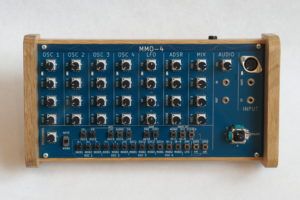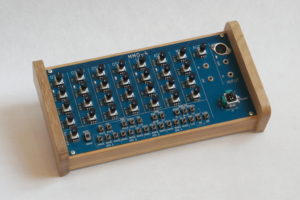This synth have been replaced by the MMO-3
Download documentation in pdf
MMO-4 is a digital, semi-modular, analogue style synthesizer. Built around Frequency Modulation Synthesis (FM), this synthesizer is mostly dedicated to atonal sound generation. From fat drones to percussive noise, MMO-4 offers a rich and complex timbre control.
 |
 |
 |
|---|
Why is it so special?
Unlike most FM synthesizers, the MMO-4 is not limited to specific modulation routing. All four oscillators can modulate/be modulated by all other oscillators. Modulation parameters are accessible thanks to 12 knobs for a continuous adjustment of the timbre.
It also offers a custom amplitude modulation technique where each oscillator amplitude can be modulated prior to a wave shaper in order to add harmonics without frequency variation.
Also, a joystick allows for easy manipulation of most parameters, for a fast and expressive control of the sound.
What is inside?
- 30 control knobs
- A joystick to control modulation parameters
- 4 oscillators
- 4 waveshaper
- 1 MIX (4 channels)
- FM and Wave shaping modulation
- 1 LFO with configurable waveform and modulation control
- 1 ADSR
- A very powerful digital connection matrix
- 2 octaves keyboard with portamento
- 1 digital matrix to control oscillator modulations
- 1 Stereo line IN with envelope follower and gate control
- 1 Stereo audio OUT
- 1 MIDI input (note / velocity / pitch wheel / control change)
- 1 analog CV IN and 1 GATE IN
Audio routing
Audio path:

Oscillators
The oscillator generates sinusoidal waveform, that can be distorted thanks to 2 kinds of modulation :
The classic FM modulation :
(grey represent the modulation waveform, black represent the resulting oscillator waveform)

The wave shaping technique used for the Amplitude Modulation :

Each oscillators have 3 modulations sources allowing the creation of very complex modulation pattern. All modulations can be individually set to FM or AM. Modulation source can be set to :
- Oscillator 1
- Oscillator 2
- Oscillator 3
- Oscillator 4
- LFO
- ADSR
- Joystick
- Audio In Left
- Audio In Right
- CV in
Since cross-modulation is possible (oscillator 1 controls oscillator 2 and oscillator 2 controls oscillator 1), all kinds of complex modulation pattern can be experimented.
Since auto-modulation ((oscillator 1 controlling oscillator 1) did not result in interesting sound, the algorithm has been changed to a more direct waveform modulation using the wave-shaper (in 2 different ways for AM or FM).
LFO
This LFO offers a unique feature : you can adjust the shape of the CV using faders instead of switches. This allows to continuously change from a rising saw to a triangle and then to a downward slope – or stop halfway between sinus and square.
The waveform (WF) fader controls the shape of the transition. It change from a straight ramp (as in a triangle or a saw), to a discontinuous change of value (as in a square), passing through a sinusoid shape.
The other fader (SYM) adjusts the symmetry of the output, i.e the ratio between rise and fall time. This fader allows to pass from a rising saw to a triangle and then a falling saw.
This LFO is very slow (since high speed modulation can be generated using the oscillators). The oscillation ranges from about 100 seconds to 0.1 second.
The LFO also provides a modulation fader in order to me modulated in both AM or FM. thanks to this modulation, very complex waveforms can be generated. Here is an example of the LFO waveform:

ADSR
This is a standard analogue ADSR :

Attack, Decay and Release time, as well as sustain amplitude can all be adjusted with faders.
The ADSR control the sound amplitude, but is also used as a modulation signal.
MIX
The 4 MIX faders allow independent adjustments of the oscillators amplitude. The MIX have 3 options regarding the stereo balance :
- MONO
- MIX
- STEREO
in MONO mode, all 4 oscillators are mixed in the same way on both right and left channel.
in STEREO mode, the oscillator 1 and 2 are only in the left channel, the 3 and 4 are only on the right.
in MIX mode, the oscillator 1 is louder in the left channel, the oscillator 4 is louder in the right channel, the 2 others are centred.
The MIX output passes through a distortion, generating modulation harmonics depending of the MIX amplitude.
VCA
The dual VCA is controlled by the ADSR. Its position in the audio chain can be changed to be before or after the distortion.
JOYSTICK
The joystick allows to mix 4 modulation signals to create a new modulation. For every direction (UP, Down, Left, Right), a modulation source can be selected. The joystick mixes these 4 modulations depending on its position. The output can be used like any other modulation.
MIDI
All the synthesizer parameters can be controlled via its midi input.
Specifications
- 30 faders, 12 bits input
- 44.1KHz audio synthesis
- about 5KHz for CV computation (modulations are at audio rate)
- 24 bits audio ADC and DAC
- 32 bits audio synthesis
- about 80 dB S/N for the audio line-out
- 0.5 ms IN/OUT audio latency
- cortex M3 32 bits micro-controller (from an arduino due)
- 9 to 12V power supply (1 standard 2.1mm power plug or 1 standard eurorack plug)
- low power consumption (300mA @ 12V)
- eurorack compatible (3U, 10 inches : 50HP)
- 280 x 150 x 60mm wood (oak) box
- about 620g
